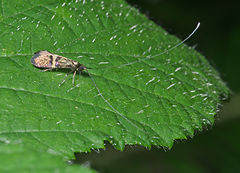Adelidae
| Fairy longhorn moths | |
|---|---|
 |
|
| Nemophora degeerella | |
| Scientific classification | |
| Kingdom: | Animalia |
| Phylum: | Arthropoda |
| Class: | Insecta |
| Order: | Lepidoptera |
| Suborder: | Glossata |
| Infraorder: | Heteroneura |
| Superfamily: | Incurvarioidea |
| Family: |
Adelidae Bruand, 1851 |
| Diversity | |
| 2 subfamilies, 5 genera and 294 species | |
The Adelidae or fairy longhorn moths are a family of monotrysian moths in the lepidopteran infraorder Heteroneura. Most species have at least partially metallic patterns coloration and are diurnal, sometimes swarming around the tips of branches with an undulating flight. Others are crepuscular and have a drab coloration. Fairy longhorn moths have a wingspan of 4–28 millimeters, and males often have especially long antennae, 1–3 times as long as the forewing.
They are widespread across the world and can be found over much of North America and Eurasia from April to June. About 50 species occur in Europe, of which most widely noted is the green longhorn (Adela reaumurella) which can sometimes reach great abundance; due to climate change its peak flying season is shifting towards spring. In general, they are more plentiful in the Northern Hemisphere, but the family occurs in the Neotropics, sub-Saharan Africa, South-East Asia and Australia too.
Adelidae are usually closely restricted to particular host plants [1], in which the females insert their eggs or just lay among leaf litter, and the caterpillars make a case, completing their development on the ground. Fairy longhorn moths feed in sunshine on nectar from the flowers of herbaceous (woody) plants.
...
Wikipedia
